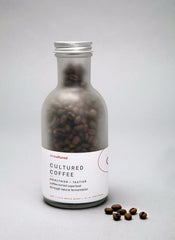Coffee Cupping: Picking The Best Beans
Several times a year, the team at eatCultured gathers for a special event: a coffee cupping. Cuppings are how we taste-test coffee to pick the best tasting and quality beans for each batch of Cultured Coffee.
Picking Coffee Beans
First, our production team selects organic green coffee beans from our supplier, Crop to Cup in Brooklyn. We typically favor African Arabica with notes of chocolate, caramel or fruit the whole family can enjoy.
We select more than one kind of bean initially to compare and contrast during the cupping. This helps us determine which coffee will be the most flavorful for our customers.

Prepping The Beans
Next, our beans undergo a signature controlled fermentation to make the coffee more digestible and provide a unique range of extra health benefits. Once the beans are fully-fermented we roast our beans at City of Saints, also based in Brooklyn.

As we roast, we monitor each batch using a roast chart to ensure a consistent roast profile. For Cultured Coffee, we generally select a medium roast profile to support a wide variety of brew methods. For cuppings, beans are roasted up to a day before and allowed to sit for up to 8 hours before tasting.

How Does A Cupping Work?
Once the beans are fermented and roasted, it’s time for a cupping! We prefer to use the method set out by the Speciality Coffee Association of America (SCAA).
First, we prep our coffee by weighing it and organizing the cupping room. We use cupping glasses made of tempered glass or ceramic material that hold 7-9 fluid ounces (207-266 ml).
Next we grind the coffee. For cuppings, beans are ground no more than fifteen minutes before cupping and more coarsely than the grind you’d use for a pour over brew. Unlike how you’d typically brew coffee at home, in a cupping it’s important to retain coffee grounds in the cup for taste and visual inspection.
Coffee grounds are then added to a cup, to which we add hot water (no filters required). The water gets heated to 200F/93ºC before being poured evenly over all the grounds and allowed to sit for 3-5 minutes prior to evaluation.
Golden Cup Ratio
The amount of coffee you use in a cupping is measured according to something called the Golden Cup ratio. You can think of this as the brew strength. It refers to the optimum ratio of coffee solids to water, which is 8.25 grams of coffee per 150 ml of water for a cupping.
Tasting Coffee
You can taste test coffee before it cools to 70F (21ºC). For a cupping test, tasters typically use the same framework to score their perception of the coffee:
- Fragrance (smell of ground dry coffee) / aroma (ground coffee infused with hot water);
- Before you add water to the coffee grounds, the dry fragrance of each cup is evaluated by lifting the lid and sniffing the dry grounds.
- After infusing with water, the resulting coffee crust is left unbroken for at least 3 minutes but not more than 5 minutes. The crust is then broken by stirring the cup 3 times and allowing the foam to run down the back of the tester’s spoon while gently sniffing.
- The overall score reflects both the dry and wet evaluation.
- Flavor, acidity, body, balance;
- When the sample has cooled to 160F (71ºC), we start evaluating the liquid coffee. The human nose is able to detect more flavors at around this temperature, which is why the coffee is allowed to cool a little to score for flavor.
- Coffee cuppers use a special technique called “aspiration” to suck coffee into the mouth, which allows the coffee to uniformly coat the tongue and upper palate.
- As the coffee continues to cool (160F-140F) we score for acidity, body and balance. Balance is the cupper's assessment of how well the flavor, aftertaste, acidity, and body fit together to build a well-rounded cup.
- Uniformity, clean cup, sweetness;
- As the brew approaches room temperature - or below 100F (37.8ºC) - the cupper evaluates these extra attributes.
- Defects; and
- Overall impression.
Scoring Coffee
Flavor attributes count as positive scores towards the coffee. Any defects noted by tasters count negatively, indicating unpleasant flavor sensations. The overall score is then a summary of the positive and negative attributes noted by individual tasters. At this point, tasters compare notes.
The Winning Beans
Whichever cup rates highest across the taste-testers will be selected for the next batch of Cultured Coffee.
While every taster’s palate is different, approaching coffee flavors using the same framework and way of approaching the complexities of each cup help to standardize perceptions as much as possible.
Even within our small team, our tasters’ personal preferences (taste and brew method) vary greatly. We embrace this diversity of palates! After all, that’s what helps us pick crowd-pleasing coffees with every fresh batch of beans.
Learn more about eatCultured's first healthy fermented product: Cultured Coffee


Leave a comment
Please note, comments must be approved before they are published